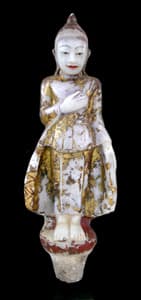Mandalay Gilt Marble Sculpture of the Walking Buddha, 19th Century CE
Gilt Marble
X.0536
The Mandalay Period represents the last great cultural flourishing of Burmese art. The period was named after the city of Mandalay, which served as capital of Myanmar for a brief...
The Mandalay Period represents the last great cultural flourishing of Burmese art. The period was named after the city of Mandalay, which served as capital of Myanmar for a brief period (1860-1885 A.D.) during the reign of King Mindon. After the Anglo-Burmese Wars, northern Myanmar was shut off from the coastal areas that were controlled by the British. King Mindon founded the new capital at a sacred site at the foot of a large hill. The center of the city was designed in the perfect geometrical form of a Buddhist Mandala, giving the city its name. Although this short-lived kingdom finally fell to the British forces in 1886 A.D. during the Third Anglo-Burmese War, the Royal Guilds that created such remarkable works of art for the King remained in the city where they continued to produce sculptures in the Mandalay style.
This type of standing Buddha is commonly referred to as the “walking Buddha.” Apparently, this posture appears to illustrate certain texts that were recorded during the Sukhothai period. Specifically, this form seems to relate to the Buddha as described in canons written during the reign of Rama Khamheng in the late 13th Century. In the city of Sukhothai, representations of the walking Buddha were found placed against the walls of temples. One hand is traditionally held in the Abhaya mudra, which symbolizes protection, benevolence, and peace, while the other arm hangs beside the body. Sometimes, one leg is portrayed advancing forwards of the other, contributing to the designation of these figures as walking. This marble walking Buddha portrays the Sakyamuni holding his right arm in front of his chest, with his hand forming the Abhaya mudra, while this left arm clutches the overhang of his robe. He stands with both his feet together upon a circular base. There are extensive remnants of the original gilding covering much of the work, specifically the robes, as well as some polychrome hues visible on the head and base.
This type of standing Buddha is commonly referred to as the “walking Buddha.” Apparently, this posture appears to illustrate certain texts that were recorded during the Sukhothai period. Specifically, this form seems to relate to the Buddha as described in canons written during the reign of Rama Khamheng in the late 13th Century. In the city of Sukhothai, representations of the walking Buddha were found placed against the walls of temples. One hand is traditionally held in the Abhaya mudra, which symbolizes protection, benevolence, and peace, while the other arm hangs beside the body. Sometimes, one leg is portrayed advancing forwards of the other, contributing to the designation of these figures as walking. This marble walking Buddha portrays the Sakyamuni holding his right arm in front of his chest, with his hand forming the Abhaya mudra, while this left arm clutches the overhang of his robe. He stands with both his feet together upon a circular base. There are extensive remnants of the original gilding covering much of the work, specifically the robes, as well as some polychrome hues visible on the head and base.



